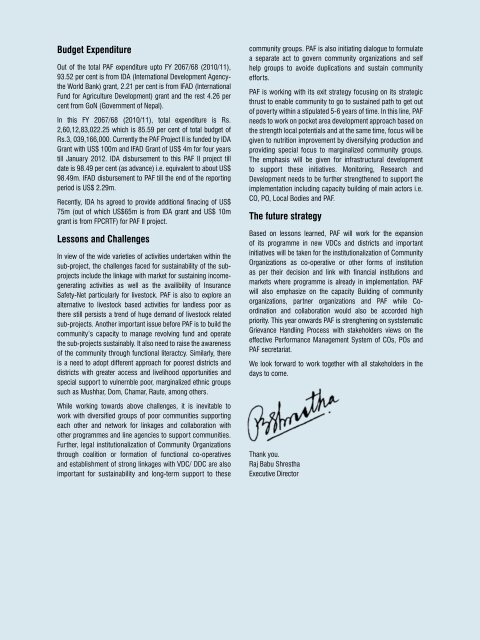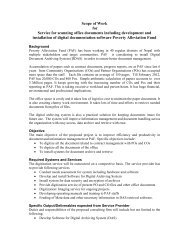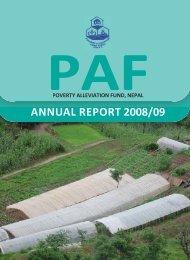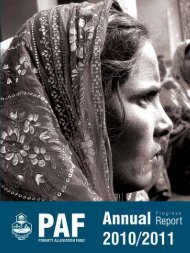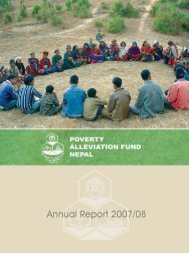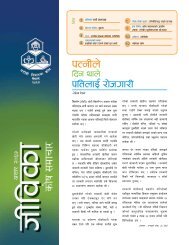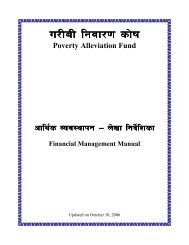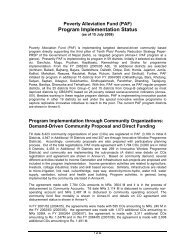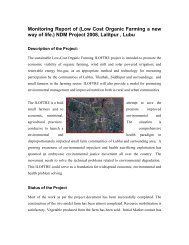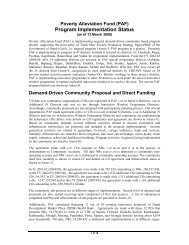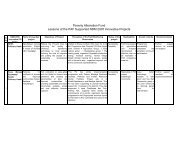Fiscal year 2010/11 - Poverty Alleviation Fund, Nepal
Fiscal year 2010/11 - Poverty Alleviation Fund, Nepal
Fiscal year 2010/11 - Poverty Alleviation Fund, Nepal
You also want an ePaper? Increase the reach of your titles
YUMPU automatically turns print PDFs into web optimized ePapers that Google loves.
Budget Expenditure<br />
Out of the total PAF expenditure upto FY 2067/68 (<strong>2010</strong>/<strong>11</strong>),<br />
93.52 per cent is from IDA (International Development Agencythe<br />
World Bank) grant, 2.21 per cent is from IFAD (International<br />
<strong>Fund</strong> for Agriculture Development) grant and the rest 4.26 per<br />
cent from GoN (Government of <strong>Nepal</strong>).<br />
In this FY 2067/68 (<strong>2010</strong>/<strong>11</strong>), total expenditure is Rs.<br />
2,60,12,83,022.25 which is 85.59 per cent of total budget of<br />
Rs.3, 039,166,000. Currently the PAF Project II is funded by IDA<br />
Grant with US$ 100m and IFAD Grant of US$ 4m for four <strong>year</strong>s<br />
till January 2012. IDA disbursement to this PAF II project till<br />
date is 98.49 per cent (as advance) i.e. equivalent to about US$<br />
98.49m. IFAD disbursement to PAF till the end of the reporting<br />
period is US$ 2.29m.<br />
Recently, IDA hs agreed to provide additional finacing of US$<br />
75m (out of which US$65m is from IDA grant and US$ 10m<br />
grant is from FPCRTF) for PAF II project.<br />
Lessons and Challenges<br />
In view of the wide varieties of activities undertaken within the<br />
sub-project, the challenges faced for sustainability of the subprojects<br />
include the linkage with market for sustaining incomegenerating<br />
activities as well as the availibility of Insurance<br />
Safety-Net particularly for livestock. PAF is also to explore an<br />
alternative to livestock based activities for landless poor as<br />
there still persists a trend of huge demand of livestock related<br />
sub-projects. Another important issue before PAF is to build the<br />
community’s capacity to manage revolving fund and operate<br />
the sub-projects sustainably. It also need to raise the awareness<br />
of the community through functional literactcy. Similarly, there<br />
is a need to adopt different approach for poorest districts and<br />
districts with greater access and livelihood opportunities and<br />
special support to vulnernble poor, marginalized ethnic groups<br />
such as Mushhar, Dom, Chamar, Raute, among others.<br />
While working towards above challenges, it is inevitable to<br />
work with diversified groups of poor communities supporting<br />
each other and network for linkages and collaboration with<br />
other programmes and line agencies to support communities.<br />
Further, legal institutionalization of Community Organizations<br />
through coalition or formation of functional co-operatives<br />
and establishment of strong linkages with VDC/ DDC are also<br />
important for sustainability and long-term support to these<br />
community groups. PAF is also initiating dialogue to formulate<br />
a separate act to govern community organizations and self<br />
help groups to avoide duplications and sustain community<br />
efforts.<br />
PAF is working with its exit strategy focusing on its strategic<br />
thrust to enable community to go to sustained path to get out<br />
of poverty within a stipulated 5-6 <strong>year</strong>s of time. In this line, PAF<br />
needs to work on pocket area development approach based on<br />
the strength local potentials and at the same time, focus will be<br />
given to nutrition improvement by diversifying production and<br />
providing special focus to marginalized community groups.<br />
The emphasis will be given for infrastructural development<br />
to support these initiatives. Monitoring, Research and<br />
Development needs to be further strengthened to support the<br />
implementation including capacity building of main actors i.e.<br />
CO, PO, Local Bodies and PAF.<br />
The future strategy<br />
Based on lessons learned, PAF will work for the expansion<br />
of its programme in new VDCs and districts and important<br />
initiatives will be taken for the institutionalization of Community<br />
Organizations as co-operative or other forms of institution<br />
as per their decision and link with financial institutions and<br />
markets where programme is already in implementation. PAF<br />
will also emphasize on the capacity Building of community<br />
organizations, partner organizations and PAF while Coordination<br />
and collaboration would also be accorded high<br />
priority. This <strong>year</strong> onwards PAF is strenghening on syststematic<br />
Grievance Handling Process with stakeholders views on the<br />
effective Performance Management System of COs, POs and<br />
PAF secretariat.<br />
We look forward to work together with all stakeholders in the<br />
days to come.<br />
Thank you.<br />
Raj Babu Shrestha<br />
Executive Director<br />
ANNUAL PROGRESS REPORT (<strong>2010</strong>/20<strong>11</strong>)<br />
vii


